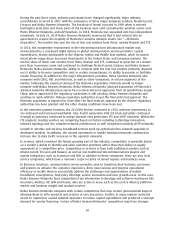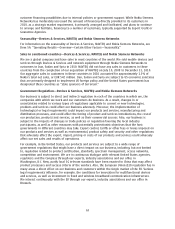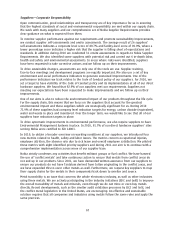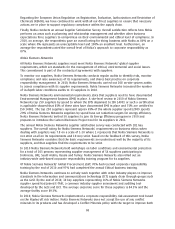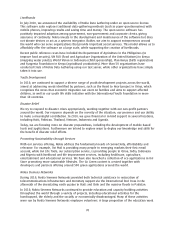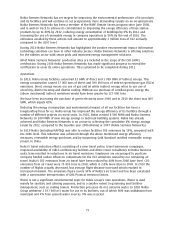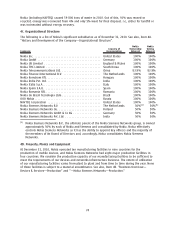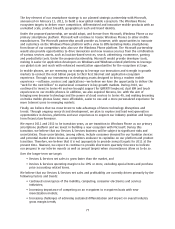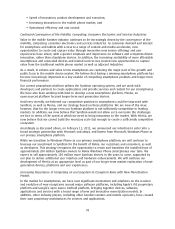Nokia 2010 Annual Report Download - page 69
Download and view the complete annual report
Please find page 69 of the 2010 Nokia annual report below. You can navigate through the pages in the report by either clicking on the pages listed below, or by using the keyword search tool below to find specific information within the annual report.Regarding the European Union Regulation on Registration, Evaluation, Authorization and Restriction of
Chemicals (REACH), we have continued to work with all our direct suppliers to ensure that necessary
actions are in place to support regulatory compliance within the supply chain.
Finally, Nokia conducts an annual Supplier Satisfaction Survey. Overall satisfaction reflects how Nokia
performs on areas such as planning and relationship management and whether other business
expectations force suppliers to compromise on their environmental and ethical level of compliance. In
2010, on average, the respondents gave an overall rating for doing business with Nokia as 80% on a
scale where 0% represents an unacceptable level and 100% an excellent level. Furthermore, on
average the respondents rated the overall level of Nokia’s approach to corporate responsibility as
87%.
Nokia Siemens Networks
All Nokia Siemens Networks suppliers must meet Nokia Siemens Networks’ global supplier
requirements, which set standards for the management of ethical, environmental and social issues.
This commitment is part of the contractual agreements with suppliers.
To monitor our suppliers, Nokia Siemens Networks conducts regular audits to identify risks, monitor
compliance and raise awareness of its requirements, and shares best practice on corporate
responsibility management. In 2010, Nokia Siemens Networks carried out 108 onsite system audits
to assess compliance with its supplier requirements. Nokia Siemens Networks increased the number
of indepth labor conditions audits to 13 suppliers in 2010.
Nokia Siemens Networks environmental requirements state that suppliers need to have documented
Environmental Management Systems (EMS) in place. A sitelevel review in 2010 of Nokia Siemens
Networks top 250 suppliers by spend to whom the EMS alignment to ISO 14001 or such a certification
is applicable showed that 85% of these sites have documented EMS in place and 75% are certified to
ISO 14001. The top 250 suppliers represent approx 69% of the whole supplier spend (2009 spend).
29% of Nokia Siemens Networks suppliers by spend have set reduction targets for energy efficiency.
Nokia Siemens Networks invited 30 suppliers to join its Energy Efficiency program in 2010 and
prepares to introduce the Carbon Disclosure Project tool for its suppliers in 2011.
The annual Nokia Siemens Networks supplier satisfaction survey was conducted with 281 key
suppliers. The overall rating for Nokia Siemens Networks’ requirements on business ethics when
dealing with suppliers was 7.8 on a scale of 110 where 1 represents that Nokia Siemens Networks is
not strict at all on its requirements and 10 very strict. Based on the feedback of this survey, Nokia
Siemens Networks considers that the basic requirements are understood well by the majority of its
suppliers, and that suppliers find the requirements to be strict.
In 2010 Nokia Siemens Networks held workshops on labor conditions and environmental protection
for a total of 103 persons representing supplier management of 54 suppliers participating in
Indonesia, UAE, Saudi Arabia, Russia and Turkey. Nokia Siemens Networks also rolled out an
industrywide webbased corporate responsibility training program for its suppliers.
Of Nokia Siemens Networks’ Global Procurement staff, 70% had received corporate responsibility
training by the end of 2010 and 97% had completed the annual Ethical business training.
Nokia Siemens Networks continues to actively work together with other industry players to improve
standards in the information and communications technology (ICT) supply chain through groups such
as the GeSI. By the end of 2010, 18 key suppliers representing 16% of Nokia Siemens Networks
supplier spend had joined ETASC, a common industry supplier assessment and auditing tool
developed by the GeSI and EICC. The average corporate score for these suppliers is 84.5% and the
average facility score 89.3%.
In 2010, Nokia Siemens Networks implemented a corporate responsibility risk assessment tool based
on the Maplecroft risk indices. Nokia Siemens Networks does not accept the use of any conflict
minerals in its products and has developed a Conflict Minerals policy with the target to improve both
68






